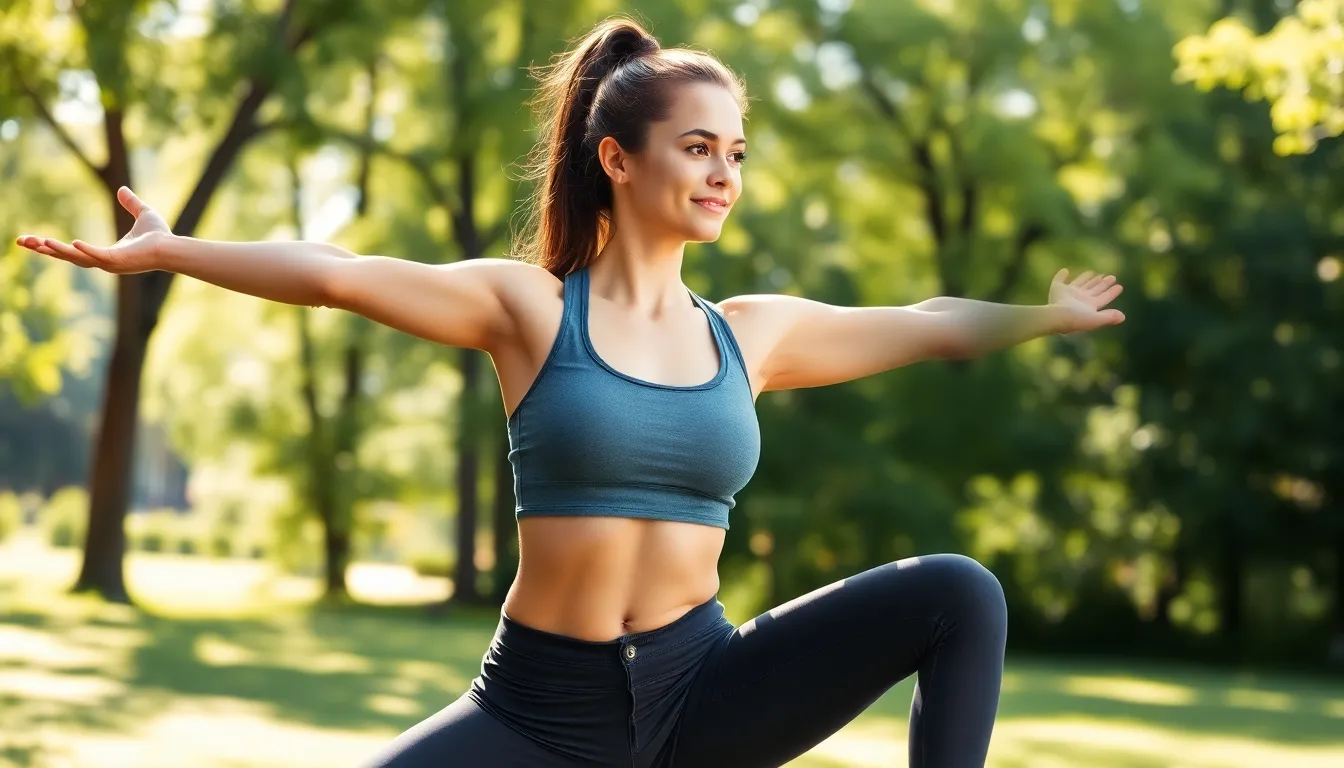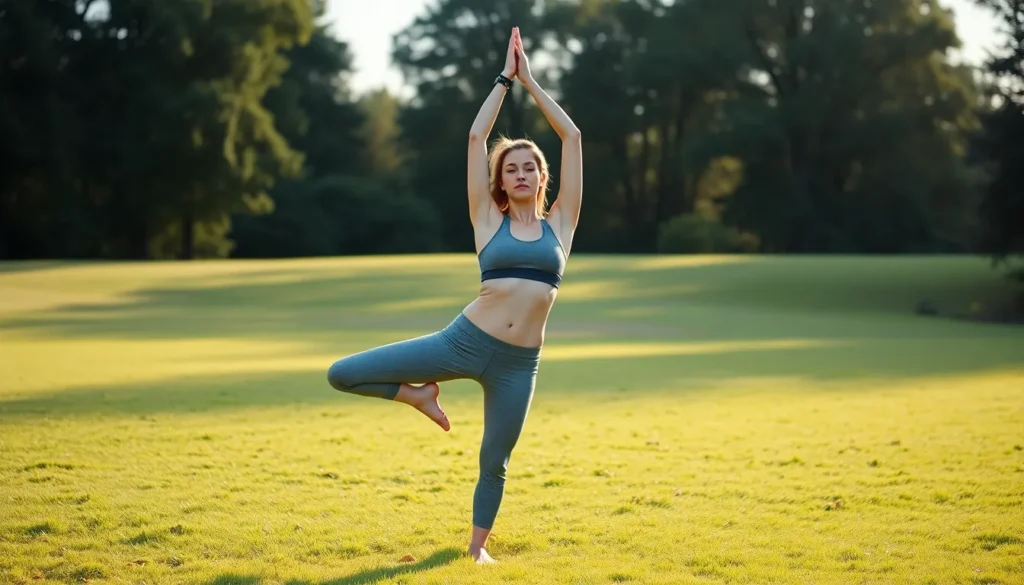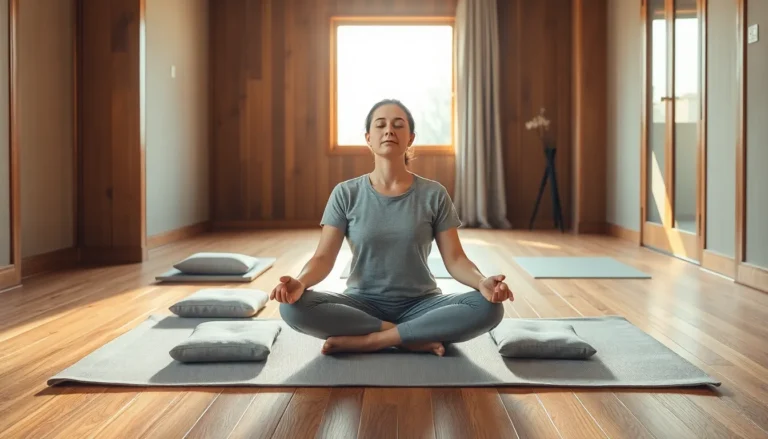Table of Contents
ToggleIn a world where stress often feels like a second job, yoga exercises might just be the perfect antidote. Imagine bending and stretching your way to tranquility while simultaneously working on that elusive flexibility. It’s like giving your body a much-needed spa day without ever leaving your living room. Who knew that mastering downward dog could also help you master the art of relaxation?
But yoga isn’t just about finding your zen; it’s a workout that sneaks up on you. One minute you’re striking a pose, and the next, you’re wondering if you’ve accidentally signed up for a contortionist class. With a blend of strength, balance, and a sprinkle of humor, yoga offers something for everyone. So roll out that mat and get ready to discover how these exercises can transform not just your body, but your entire outlook on life.
Overview of Yoga Exercises
Yoga exercises encompass a wide range of postures and movements designed to enhance physical and mental well-being. Practitioners can choose from various styles, including Hatha, Vinyasa, and Ashtanga, each offering unique benefits. Hatha yoga focuses on foundational postures and breathing techniques, making it ideal for beginners. Vinyasa practice emphasizes fluid movement and breath coordination, creating a dynamic flow.
Core strengthening is another essential aspect of many yoga routines. Engaging the core not only improves stability but also supports overall posture. Some key poses for core engagement include Plank, Boat, and Side Plank. Advanced practitioners might explore incorporating these into their daily practice to achieve greater strength and balance.
Balance poses also play a significant role in yoga exercises. Stand on one leg during Tree Pose or Warrior III to build stability and enhance focus. Such poses not only challenge the body but also improve mental clarity, resulting in a more centered state of mind.
Flexibility benefits arise from various stretches and deep breathing techniques inherent in yoga. Many routines incorporate forward bends, backbends, and twists, allowing muscles to lengthen and recover from daily tension. Regular practice can significantly increase flexibility over time, positively impacting daily activities and overall mobility.
Meditation techniques often complement physical postures, helping to cultivate mindfulness. Incorporating meditation into yoga sessions fosters relaxation and a deeper connection with one’s body. Practitioners report increased emotional resilience and an enhanced sense of well-being, reinforcing yoga’s dual nature as both a physical workout and a mental sanctuary. Understanding these pillars helps practitioners maximize yoga’s transformative potential.
Benefits of Yoga Exercises

Yoga exercises offer numerous advantages for both body and mind. Practicing regularly enhances overall well-being and promotes a healthier lifestyle.
Physical Benefits
Yoga enhances flexibility through various stretches and postures. Muscle strength improves with key poses such as Plank, Boat, and Warrior III. Joint health receives attention, as many yoga movements encourage better range of motion. Increased blood circulation results from the combination of deep breathing and movement. Another benefit lies in posture correction, as yoga strengthens core muscles and aligns the spine. Regular practice aids in weight management and boosts metabolism, contributing to physical vitality. Striking a balance between strength and flexibility fosters injury prevention for athletes and active individuals alike.
Mental Benefits
Yoga cultivates mindfulness, allowing practitioners to focus on the present moment. Stress reduction plays a critical role, as the combination of breathing techniques and meditation lowers cortisol levels. Improved mental clarity and concentration arise during practice, helping individuals in daily tasks. Enhanced emotional resilience comes from developing a deeper awareness of thoughts and feelings. Additionally, yoga encourages relaxation, promoting better sleep quality. A positive outlook often results from consistent yoga practice, contributing to improved overall mental health.
Popular Yoga Exercises
Yoga offers various exercises, each catering to different needs and skill levels. Here’s a closer look at some of the most popular yoga styles.
Hatha Yoga
Hatha yoga serves as an excellent introduction to yoga practice, focusing on foundational postures and breathing techniques. Beginners often appreciate its slower pace, which emphasizes alignment and mindful movement. Practicing Hatha encourages awareness of body mechanics, enhancing flexibility and strength over time. Often, classes incorporate gentle stretches and relaxation techniques, making them accessible for all fitness levels. Improved posture and reduced stress are common outcomes for participants.
Vinyasa Yoga
Vinyasa yoga stands out for its dynamic flow, linking breath with movement. This style allows for creative sequences, enabling practitioners to transition fluidly between poses. Consistent practice builds strength, endurance, and cardiovascular fitness. Typically, Vinyasa classes accommodate various skill levels, encouraging modification of poses to suit individual needs. Participants often report feeling energized and mentally clear after sessions, highlighting the blend of physical exertion and mindfulness.
Ashtanga Yoga
Ashtanga yoga follows a structured sequence of poses, promoting discipline and consistency in practice. This vigorous style incorporates a specific series of postures done in a set order, making it ideal for those seeking a challenge. Practitioners experience a powerful workout that builds strength and flexibility over time. Each session includes a focus on breathing techniques, enhancing mental clarity. Aspiring yogis can expect improvements in both physical and mental resilience through regular Ashtanga practice.
Tips for Practicing Yoga Exercises
Practicing yoga effectively involves choosing the right style, creating an inviting space, and prioritizing safety. These elements enhance the overall experience.
Finding the Right Style
Choosing a yoga style that suits personal preferences significantly impacts practice. Hatha yoga is perfect for beginners, focusing on postures and breathing. Vinyasa offers dynamic flow, appealing to those who enjoy rhythm in movement. Ashtanga provides a structured sequence for practitioners seeking a challenge. Exploring various classes helps identify what resonates most. Many studios offer introductory sessions, allowing individuals to experience different styles before committing.
Setting Up Your Space
Creating a dedicated practice area fosters relaxation and focus. Find a quiet corner free from distractions, and lay down a comfortable mat. Incorporate calming elements like plants or soft lighting to enhance the ambiance. Keep essentials nearby, such as water and props like blocks or straps, to support poses. Arranging the space thoughtfully encourages a peaceful mindset, making the practice more enjoyable.
Safety Considerations
Prioritizing safety during yoga practice reduces the risk of injury. Listening to the body’s signals is crucial; discomfort indicates the need for adjustments. Modifying poses or using props aids in maintaining proper alignment. Attending classes with experienced instructors provides guidance on safe techniques. Understanding personal limits ensures practices remain beneficial without strain. Yoga should promote wellness, not lead to injury or discomfort.
Embracing yoga exercises offers a pathway to enhanced well-being and personal growth. With its diverse styles and benefits, yoga caters to everyone regardless of fitness level. Regular practice not only strengthens the body but also nurtures the mind, fostering a sense of balance and calm.
By integrating various poses and meditation techniques, individuals can experience profound transformations that extend beyond the mat. As practitioners explore different styles and find what resonates with them, they’ll uncover a fulfilling journey that promotes both physical health and mental clarity. Yoga is more than just a workout; it’s a holistic approach to a healthier lifestyle.







